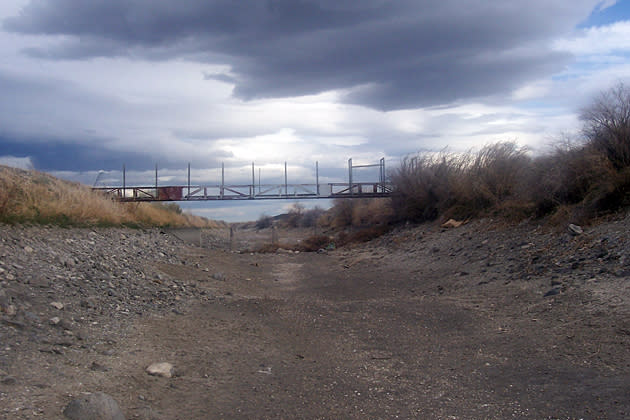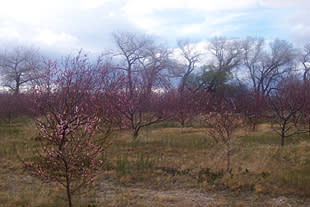 The Lookout
The LookoutDrought diaries: How no water, extreme heat are hurting Americans

The dry Truckee Canal near Teresa Pena-Raney's peach orchard in western Nevada. (Teresa Pena-Raney)
Along the 195-mile Embarras River, a tributary of the Wabash in southeastern Illinois, rancher Jim Gardner worries about his 200 head of Angus cattle.
There's enough hay--for now. But in July, the cattle started eating winter's food, and this year's drought has already browned his fields. When the rain stopped, the ranch cut the hay for feed. The fields are now barren.
"You have a choice: Spend money to buy hay or spend money on fuel to get hay. We may be looking for hay again in October," Gardner writes in a first-person piece for Yahoo News.
Cattle from Jim Gardner's ranch take shelter in the shade. The dry fields are in stark contrast to 2010, when the fields were vibrant green. (Jim Gardner)
The Embarras flows north to south, meandering through seven Illinois counties that have all been designated as "extreme" drought by the federal government. Like more than 1,500 counties across the country, water along the river is sparse or non-existent.
"The ponds are gone. They're just big craters now. The trees are dropping leaves, diminishing what little shade they have," Gardner writes. "Dust billows up like a giant wave, rising through barren locust trees when the cows head to pasture."
He said that this May he improved two fields by spreading turkey manure on them--and it worked, sort of. They were last fields to turn brown in the drought.
"For more than 100 years, someone from our family has worked this dry ground," he writes. "Every decision we make carries risk of failure of ending that tradition."
Gardner's story is one of undoubtedly thousands of drought-related anecdotes from across the United States. There's plenty of misery to spread around: On Wednesday, the U.S. Department of Agriculture named 218 additional counties to its tally of natural disaster areas, raising the number of counties nationwide with drought designations to 1,584 in 32 states. And--as millions of Americans have learned this summer--if it's not the drought that's problematic, it's the drought's ugly cousin: the heat wave.
Yahoo! News asked Americans--ranchers, farmers, city-dwellers and anyone impacted--to share snapshots of living in drought and extreme heat. Below are a handful of their stories.
Teresa Pena-Raney's peach orchard in 2011 in better days. (Teresa Pena-Raney)
Out west, smack in the middle of the Nevada desert, the peach orchard run by Teresa Pena-Raney's family is in jeopardy. She says the drought has been "the story for quite some time" in Hazen, this small community about 50 minutes east of Reno.
"A lack of water and drying trees are an everyday concern for my family. I've watched my parents' dreams shattered over the last year, and I fear no end is in sight." Pena-Raney writes that the orchard, MacKie Farms, has survived because of her family's hard work, dedication and dreams.
But a local water irrigation consortium shut off water from the nearby Truckee Canal, leaving Hazen bone-dry. At one point, water was shut off for eight months, she writes.
"This just doesn't mean agricultural water, either; this meant water to residents' wells too. As our neighbors watched their fields dry up, we watched others go into turmoil with no running household water either.
"I realize the heat, stuck in the high 90s every day, has quite a bit to do with local hardships. And if the politics hadn't hit our farm first, the heat would have. With the water, we can save our farms. In the meantime, I'm just going to keep hauling water in buckets until the last tree is gone."
"Nature is screwing with us," Kayla Stanley writes from Napoleon, a southern Michigan town of about 1,250 residents. "The grass is not only brown and dead. The grass is hard and does not bend; it snaps."
Napoleon is under a severe drought advisory. Stanley writes: "I have to make sure my mother does not throw cigarette butts on the grass in fear we will blow up in a wild raging fire. People in the Midwest are painting their grass green because of water bans. The last time we cut the grass was months ago. No rain = no growing grass."
In Olney, Ill., lumberyard worker Kenneth Zimmerle labors outdoors through 100-degree days, low humidity and no rain--"maybe three rains since April," he writes.
"Some days I am so exhausted from the heat, I have been going to bed before 8 p.m.," Zimmerle writes. "This triple-digit heat has also affected our business since it is almost impossible to put shingles on in this type of weather. There are only a few hours a day that this can be done."
He says crops--mainly corn--in this area of eastern Illinois are dried, dead and worthless. Trees are breaking because there's no water. Flowers and plants are yellowing or dead. He hasn't mowed his lawn in more than three months.
"As we approach the halfway point in summer, there is no sign of relief from the drought," he writes.
The Kay County, Okla., corn crop has been almost destroyed by the drought. The corn field is located between Ponca City and Tonkawa along Highway 60. (Marie Lowe)
While mercury rises in Oklahoma--it hit 112 in Pawhuska, Okla., on Tuesday--the water levels have plummeted, bolstering chances of wildfires.
"More than 50 of Oklahoma's 77 counties have issued burn bans and many are pressuring Gov. Mary Fallin to issue a statewide burn ban," Marie Lowe writes from Pawhuska. "The pressure was increased this week after a wildfire destroyed homes in Stillwater."
In Kay County, firefighters responded to seven fires in seven days in July.
In Blackwell, the main water source, the Chikaskia River, was measured at 1.74 feet on July 20 and water restrictions were put into place. On July 31, water measurements were as low as 1.23 feet.
"I noticed several creeks and ponds that are no longer there," Lowe says. "One creek named Lost Creek appears to be literally lost. In Newkirk, a pond located near a casino is no longer there and neither are the cattle that used to drink out of it."
In Iowa, even the weeds are having trouble. Kimberly Schatz, who has lived nearly her whole life in the northeastern farming community of Shell Rock, writes that the dust clouds are so thick that they move through the yard like a fog.
"Looking out at the corn and bean fields surrounding our home, I have watched them deteriorate almost daily over the past couple of weeks," she writes. "The corn field on the south side started browning at the roots more than two weeks ago, but the fields to the west have just started browning at the roots in the last four or five days."
Schatz's vegetable garden is withering: onions dying off, corns and beans producing very little crops and apples rotting as soon as they ripen.
"I have not had to mow our five acres in more than a month because it is all dead," she writes. "We have weeds popping up, but even those are far and few between."
For Rhoda Auerbach, a retired San Antonio resident, it's the drought's little things that are piling up:
"On Monday, I couldn't open the side door because it faces west and the heat is so extreme that it fused the weather stripping to the door frame. I'll have to get that fixed.
"The dog next door was lying under my outdoor faucet praying for a leak.
"I haven't planted anything in my yard for quite a long time; brown plant life would clash with the house.
"The neighborhood cats drink from my pool even though the chlorine makes them ill.
"I opened my car door using gloves so I wouldn't singe my hands. I started the car with the door open to reduce the effect of the hot air blasting from my A/C."
But at least there is A/C … right?
Not for everyone. In West Berlin, N.J., Laura Cushing's air-conditioning went kaput in July. She's taken to lying down face-first on the kitchen tile, mimicking her cats, whom she believes have figured out the secret to staying cool.
"The air conditioner picked a hell of a time to die," she writes. "A week into record high hot weather, leaving my husband and I soaked in sweat any time we moved more than a few inches in our third-floor apartment. The cats have been camped out on the kitchen tile, so immobile we have to poke them once in a while to make sure they haven't lost one of their nine lives.
"I've stuck my head into the refrigerator more times than a grown woman should admit to. I've licked ice cubes, wrapped my head in a bag of frozen peas. Tried running my wrists under cold water, and laying a wet towel over the back of my neck. I'm still hot."



